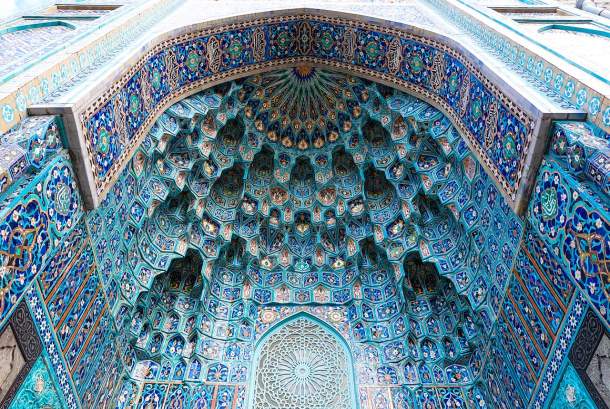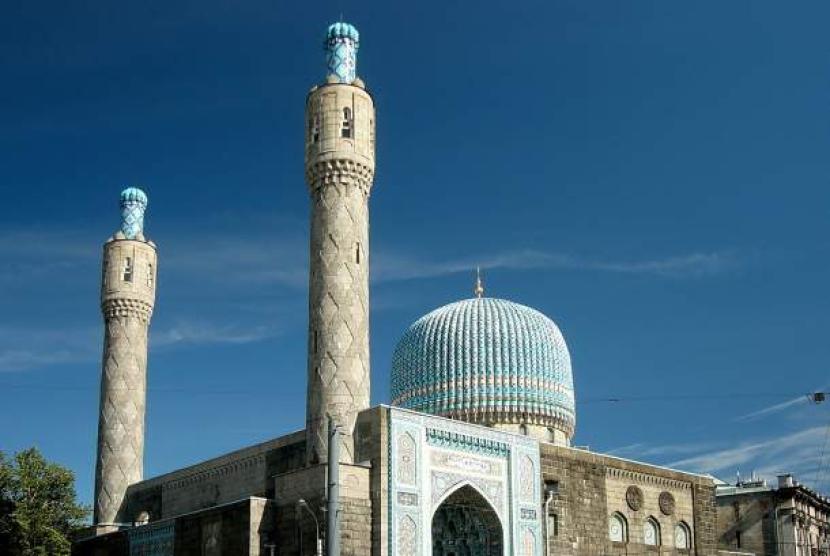According to a Pew Research Center survey in July 2016, Russia is the country with the largest Muslim population on the continent of Europe. No less than 10 percent of the population or as many as 14 million local residents embrace Islam. To facilitate them, there are about 15,000 mosques standing in the country known as the Land of the Red Bear.
One of the mosques of high historical value in Russia is the Great Mosque of Saint Petersburg. Its age has now exceeded a century. In the early days of the establishment of the place of worship, about eight thousand Muslims settled in the City of Saint Petersburg.
To date, the Muslim population of the second most populous city in Russia after Moscow reaches about 700 thousand inhabitants. They come from 22 different tribes of nations. Among them are Tatars, Azeris, Kazakhs, Uzbeks, and Chechens.
The construction of the Great Mosque of St. Petersburg was completed in 1913. At that time, St. Petersburg was the capital of the Russian Empire under the control of Tsar Nicholas II. The founding of the mosque was also as a 25th anniversary of the Abdul Ahat Khan Dynasty of Bukhara, which at that time became part of Russia.
The Grand Mosque of St. Petersburg has two towers 49 meters high and its main dome reaches 39 meters. In all, the building can accommodate up to five thousand worshippers.
In the span of 1940-1956, the Grand Mosque of St. Petersburg was forcibly closed by the regime of the Soviet Union. Instead of simply being abandoned, the Communist-led government changed its function. The mosque was transformed into a storehouse of medical tools, especially during World War II.
However, this policy was loose especially after the visit of the president of the Republic of Indonesia, Sukarno. As Tomi Lebang recounts in his book, Old Friends, The New Era: 60 Years of Ups and Downs in Indonesia-Russia Relations (page 22), Bung Karno when in St. Petersburg crossed the Trinity bridge that bisects the Neva River. The eyes of the RI proclamation were then fixed on a beautiful building with a blue dome. He then visited the place with his group.
How enchanted Bung Karno is at this building, whose original purpose was obviously a mosque. Too bad, its functions by then have been switched to a food warehouse. The RI-1 also wants the building to be re-used as a mosque, as usual. “A number of the planned visits of President Sukarno to Leningrad were canceled,” recalled the imam of the Grand Mosque of St. Petersburg, Zhapar N Panchaev, as quoted by the book.

Later, Sukarno met the Russian leader. When asked about his impression of Leningrad (the name of St. Petersburg at the time), Bung Karno asked about the building of the (former) mosque he had just seen. “Sukarno requested that the mosque be restored to its proper function. So, just 10 days after the visit of president Sukarno, the building became a mosque again,” Panchaev explained.
The complex was eventually re-purposed as a mosque in 1956. However, a major renovation was carried out only in 1980.
The building style of the house of worship called “Blue Mosque” is indeed typical of Central Asia. The designer was Nikolai Vasilyev, architect born in Yaroslavl, Russia, in 1875. In addition to the Grand Mosque of St. Petersburg, Vasilyev's other works are the German Theater Building in Estonia, which he worked with Aleksei Bubyr, also a Russian citizen.
The architect Vassiliev was elected with previous passes in sayembara held by local authorities. He managed to save 45 other draft pictures at the event. To build the Grand Mosque of St. Petersburg, Vassiliev worked with other architects, von Gogen and Krichinsky. As reported by the Enlight website.
Overall, the mosque is inspired by the architectural styles prevalent in Central Asia during the reign of the Timur king Lenk. On the walls of both the exterior and the interior, there are beautiful calligraphic strokes. It looks so harmoniously combined with a checkered mosaic that is graded in blue.
The main room for men to pray is located on the first floor. Female worshippers are given a place to pray on the second floor of this mosque. There are also rooms on the third floor of the Grand Mosque of St. Petersburg reserved for students, especially on Sundays. They studied Islam as well as Arabic and the Tatar language. Education and the holding of worship is managed by the St. Petersburg Muslim Community Agency.
Today, the Great Mosque of St. Petersburg is still considered one of the largest mosques in the Blue Continent. Its function is not only related to worship, but also as a center of Islamic education and culture in Russia or Europe in general. In fact, it is also a tourist destination, because it is located close to places that attract the attention of tourists, such as Peter-Paul Fortress.
Especially every Friday, the Grand Mosque of St. Petersburg is more lively with worshippers coming from all corners of the region. They taught the Qur'an and gave lectures on hadith. The languages spoken in general are Tatar and Russian.


